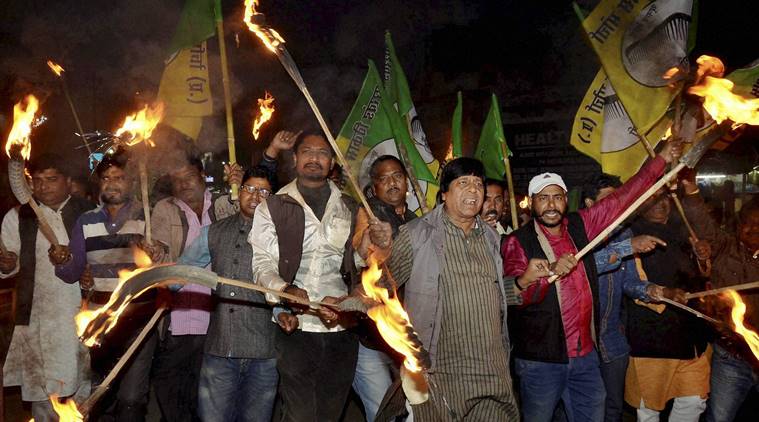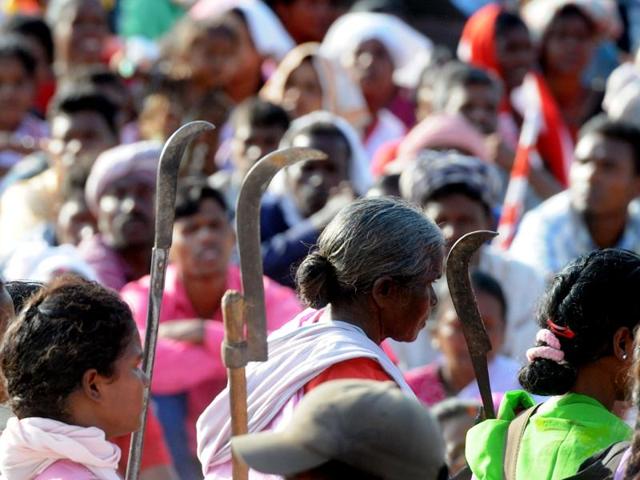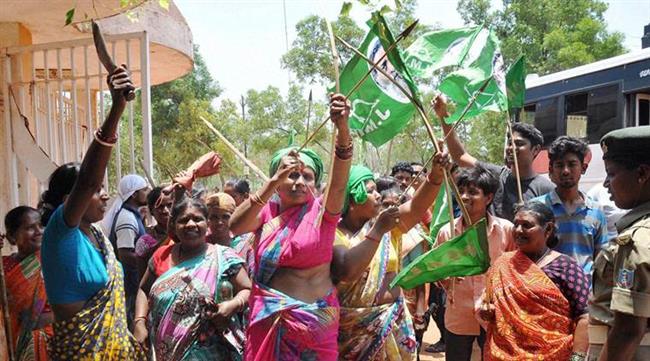The state-wide protests in Jharkand last Friday, December 3 and 4 had Section 144 being imposed all over the state and police posses outside every district college and university. The ‘national media lense’ was absent even as Jharkand, one of India’s youngest states was and is on the boil after the BJP-dominated State Assembly illegally passed amendments to the Chotanagpur Tenancy Act and the Santhal ParganaTenency Act, with a sinister aim to snatch away the rights of India’s Adivasis; even as State Repression increases, the Indigenous People’s have resolutely and peacefully fought back to reclaim what is theirs

Historic Injustice: The Supreme Court of India in a landmark judgment (Criminal Appeal No: 11 of 2011) has observed:
“The injustice done to the tribal people of India is a shameful chapter in our country's history. The tribals were called `rakshas' (demons), `asuras', and what not. They were slaughtered in large numbers, and the survivors and their descendants were degraded, humiliated, and all kinds of atrocities inflicted on them for centuries. They were deprived of their lands, and pushed into forests and hills where they eke out a miserable existence of poverty, illiteracy, disease, etc. And now efforts are being made by some people to deprive them even of their forest and hill land where they are living, and the forest produce on which they survive.” [section 36].
Law vs People: Realising this injustice, the British rulers introduced some legislation with a view to protect the tribal people and their rights over natural resources. Chotanagpur Tenancy Act, 1908 (CNT) and SantalPargana Tenancy Act, 1949 (SPT). These laws were meant to prevent land-alienation of the indigenous Adivasi community. However, over the years some loopholes were introduced in the law, especially in the CNT Act through which indigenous land can now be taken for public sector undertakings such as mines and industries. Under this guise or pretext, thousands of acres of land has been forcibly appropriated from Jharkand’sAdivasis using the outdated Land Acquisition Act of 1894 enacted by the British. The compensation fixed by petty bureaucrats has been meagre without any rehabilitation of the displaced. A minimal estimate is that about 24 lakh acres of land was thus alienated and 19 lakh people have been, over the decades, displaced. A cruel, further push in this policy of unfair seizure of land was brought in with the neo-liberalisation policies adopted from the early 1990s, that has paved the way for private industrialists to invest in mining and industries.
MoUs on paper only: Even as the government went on signing Memorandum of Understandings (MoUs) with prospective industrialists, people’s resistance movements began to emerge.Consequently very few industrialists could set up their industries leading to an industrial deadlock and most of them had to go back empty handed.Big projects such as Neterhat Field Firing Range, Koel-Karo River-Water Project, Arcelor-Mittal project where the people’s collective resolve not to give their land are some of the success stories of people’s resistance.
It was in such a predicament that UPA government enacted the ‘Land Acquisition Act, 2013’ by which better compensation and rehabilitation was offered. Some significant features of this 2013 law are: (1) compensation amount enhanced to four times the market rate, (2) obtaining environment clearance for the industry/mine, (3) obligatory public hearings wherein the consent of 80% for private industries and 70% for public sector industries, (4) social audit by independent expert group to assess the economic, social, cultural impact on the communities because of the industry/mine functioning in their midst. Only on the satisfactory fulfillment of the above conditions, industries/mines would be given the go-ahead signal.

Mass protests overwhelm 2013 Ordinanceof the NDA II government to scrap the salient features of the 2013 Land Acquisition Act. This was a desperate attempt to salvage the assurances the government had made to industrialists that they would face no problems in setting up industries. This arrogant action of the government aroused intellectuals, farmers associations, working class, Dalit and Adivasi communities to take to the street at local, regional, national levels and denounce the duplicity of the NDA govt. This determined protest by the masses finally brought the government to its knees and forced it to withdraw the much-criticisedOrdinance.
Shifting the burden of dismantling the 2013 Land Acquisition Act to State Governments—especially those ruled by the BharatiyaJanata Party (BJP), the NDA government asked the States to enact their own laws / ordinances / amendments so that corporate entities can easily acquire land and start their industries and mines. Now that Jharkhand Government is also a BJP government and has been faithfully carrying out the dictates of it’s national one, the NDA II government worked out the sinister plan of passing an Ordinance which sought to tamper with both laws, the CNT & SPT Acts.
This Ordinance was passed by the JharkandState Cabinet just a few days before the commencement of the State Assembly on July 28, 2016. Such an important and crucial t should rather have been placed in the Assembly for appropriate discussions and deliberation. But the government knew it would be difficult to get such changes through since the opposition would oppose it vehemently. Extremely unfortunately, the State Governor signed this irregularly brought Ordinance and forwarded it to the President of India for his approval after which it would become a law. Fortunately, the President had the discretionary sense to forward it to the Central Government and the National Commission for Scheduled Tribes for their comments. While the central government has been silent on the matter, the ST Commission responded saying it would be highly unconstitutional to pass such an Ordinance. Nearly five months have passed and the President has not given his approval. This Constitutional brakes have placed both the NDA II government at the centre and the state government in Jharkhand in an awkward situation where their designs against the indigenous people, Adivasis of the state, have not materialised.
Ordinance becomes Amendment: The Jharkhand Government then proposed Amendments to CNT & SPT Acts, offering these as ‘good’ and ‘necessary’ for the larger good of ‘development’. This ploy too, has, however not worked and a widespread mobilisation among Adivasi groups and indigenous peoples has been roundly protesting these moves.
Where the attendance register becomes ‘consent’ document: Sensing the predicament of the government, indigenous parties, organisations and movements demanded that the Vth Schedule of the Constitution be observed in letter and spirit and that government’s proposed amendments should first get the approval of Tribes Advisory Council (TAC) before they are presented on the floor of the State Assembly. The state government, keen to appear to be abiding by constitutional requirements convened a formal meeting of the TAC in September 2016 but this turned out to be mere tokenism and something of a farce: the Chief Minister who is not even a tribal made himself the ‘chairman’and conducted the meet. The attendance register of this farce of a meeting was put forward as the ‘consent’ document and the general public was informed through the ever-obliging, and largely uncritical, media that the resolution of the government had been passed by the TAC!
A three-minute miracle! Opposition to the proposed Amendments to CNT & SPT Acts swelled. Protests became vociferous with both indigenous mass movements and opposition political parties, participating. Rallies, public meetings against the amendments became the order of the day. Opposition parties assured the people that they would not allow the bill to be passed in the State Assembly.Both the ruling party and the opposition parties were geared up for the battle and an obvious tension prevailed all over the state. When the State Assembly gathered, the opposition parties members were up on their feet and demanded that the bill be discussed first before any attempt was made to pass it. An uproar prevailed but then, then lo and behold it was unilaterally announced that the Bill has been passed by a voice vote! All this took place in a matter of three minutes!
It is NOT agricultural land for non-agricultural purpose… BUT snatching indigenous land for out-sider industrialists. What are the objectionable elements in the proposed amendments? (1) Article 49 allowed transfer of indigenous land only to industry and mining. The proposed amendment will open the door to creating infrastructure, rail lines, colleges, hospitals, transmission lines etc. etc. in fact for any and every thing. (2) Article 21 restricted the use of agricultural land only for agricultural purpose. In other words, agricultural land cannot be changed to non-agricultural business purposes. The proposed amendment will allow any and every non-agricultural use.
It is important to keep in mind that whatever agricultural land is still in possession of the Adivasi and indigenous community, has been possible because of Article 21 of CNT and Article 13 of SPT Act. If the amendments actually become “law”, no land will be left with indigenous communities. A frightening reality indeed!
This plot of the capitalist ruling class against the India’s Adivasis and Indigenous Peoples must be resisted at all costs. If we fail in this struggle, Indigenous Communities will be wiped out in the map of central India.
An appeal to the Media too: The glare and gaze must reach where repression is at its height. Jharkand is one such today.
Human Rights Day, 2016
Related Articles:
1. It is a Multi-Pronged Assault: Civil, Political Rights & Forest, Land & Labour Rights Under Threat in the Modi Regime
